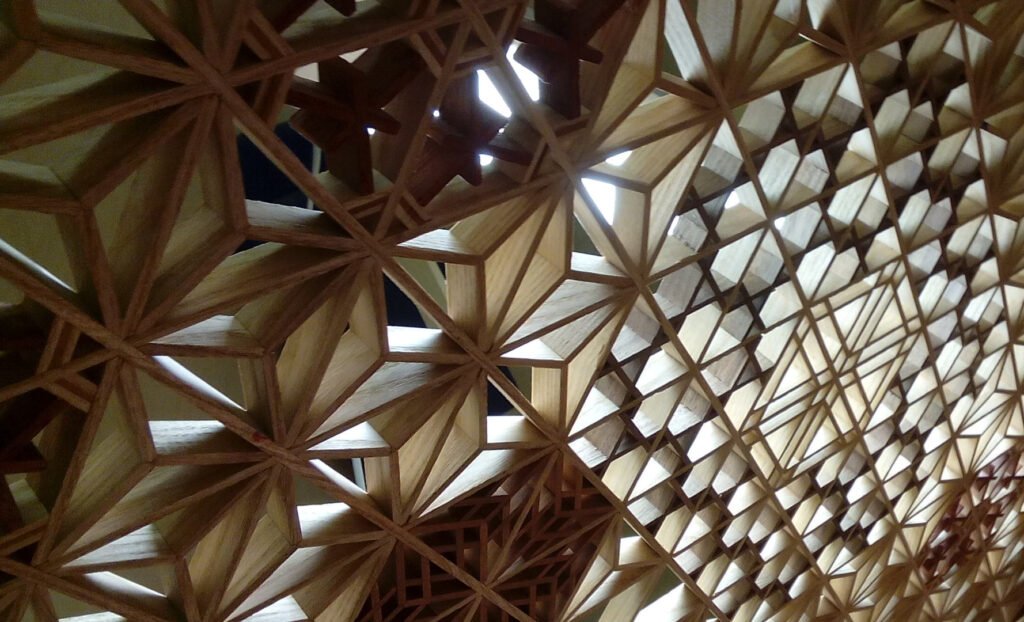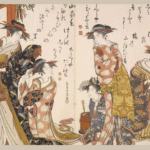The Japanese craft of Kumiko—wooden lattice work created without nails through precise joinery—represents a geometric art form that transcends mere decoration. Following our exploration of hemp leaf patterns, this article examines the diamond and lattice Kumiko patterns, revealing their historical significance, symbolic meanings, and enduring appeal in contemporary design.
To View the Complete List of 40 Kumiko Patterns:
Understanding Diamond and Lattice Kumiko Patterns
Diamond and lattice Kumiko patterns represent foundational motifs in Japanese design tradition. Diamond patterns, inspired by water plants, symbolize prosperity and vitality, while lattice patterns express harmony through intersecting lines, balancing protection with openness.
These patterns evolved from the Nara and Heian periods (710-1185) and became increasingly refined during the Edo period (1603-1868) in townhouses and temples. Their timeless beauty continues to influence designers worldwide, bridging traditional craftsmanship with contemporary aesthetics.
Ten Essential Diamond and Lattice Kumiko Patterns
Hishi (Diamond)
The Hishi pattern stylizes water chestnut forms into elegant diamond shapes. The water chestnut’s ability to extend stems from underwater while maintaining strong roots gives this pattern its symbolic meanings of “prosperous descendants,” “vitality,” and “strong will.”
Used as a family crest since the Heian period, this versatile pattern often serves as the foundation (jigumi) in complex Kumiko works. Its clean geometric beauty resonates with modern minimalist design, demonstrating remarkable adaptability across centuries.
Futae-Bishi (Double Diamond)
Futae-Bishi features overlapping large and small diamonds, creating visual depth and rhythm. The “double” element reinforces wishes for family prosperity and protection, while the image of larger diamonds encompassing smaller ones symbolizes parental protection and family security.
Used prominently in shoji screens and transoms, this pattern transforms beautifully with changing light, creating dynamic shadow play that enhances interior spaces throughout the day.
Mie-Bishi (Triple Diamond)
Mie-Bishi creates complex dimensionality through three overlapping diamonds. In Japanese tradition, the number “three” represents completeness, adding wishes for “perfect prosperity” to the diamond’s inherent symbolism of vitality.
This intricate pattern requires advanced technical skills, making it highly valued as a demonstration of Kumiko mastery. Its mathematical precision and visual complexity attract admirers across cultural boundaries, appearing increasingly in contemporary Western interiors.
Izutsu-Bishi (Well Frame Diamond)
Izutsu-Bishi stylizes ancient well frames, characterized by bold quadrilateral formations. Wells, as central life-sustaining features of traditional villages, imbue this pattern with profound meanings of “protecting life” and “wealth springing forth.”
The pattern connects to Japanese literature through “The Tales of Ise,” where childhood sweethearts measured their growth against a well, adding emotional dimensions of “growth” and “enduring bonds” to its symbolism. This multifaceted cultural significance makes Izutsu-Bishi particularly rich in meaning.
Senbon-Kōshi (Thousand-Bar Lattice)
Senbon-Kōshi arranges thin vertical bars at equal intervals, creating visual rhythm and depth. Though simple, this pattern transforms dramatically with changing light, bringing both tension and tranquility to spaces.
Functionally, these lattices admit light and breeze while blocking direct views—a perfect example of Japanese architectural wisdom. Symbolically, the grid squares “ward off evil,” while parallel lines express “order” and “harmony.” This pattern remains essential in traditional and contemporary Japanese-inspired architecture worldwide.
Hishi-San-No-Ji-Kuzushi (Diamond Three-Character Arrangement)
This sophisticated pattern derives from Edo-period mathematical calculation sticks (sangi) arranged for both calculation and beauty. It represents the Japanese cultural value of finding aesthetic pleasure in intellectual pursuits.
Traditionally associated with learning and wisdom, it carried wishes for children’s academic success. Its orderly linear arrangement expresses values still relevant today: “structured living” and “clear thinking.” This elegant connection between mathematics and art makes the pattern particularly suitable for contemporary spaces valuing both tradition and innovation.
Tsuzuki-Izutsu (Continuous Well Frames)
Tsuzuki-Izutsu connects well frames in continuous sequence, transforming individual symbols into an expression of “unceasing blessings” and “perpetual prosperity.” Its rhythmic regularity balances strength with movement—a hallmark of Japanese aesthetic sensibility.
The pattern’s literary connections to “The Tales of Ise” add emotional depth, symbolizing “unchanging feelings” and “eternal bonds.” This combination of structural stability and emotional resonance makes it particularly valued in both traditional architecture and contemporary design contexts.
Komochi-Bishi (Child-Bearing Diamond)
Komochi-Bishi arranges thin slats around a central thick one, resembling a parent embracing children. This visual metaphor embodies wishes for “family prosperity,” “intergenerational bonds,” and “continuity.”
The contrast between the strong central element and delicate surrounding pieces beautifully expresses Japanese family values, honoring both protection and nurturing. This pattern powerfully evokes familial connections, making it meaningful in both traditional and modern contexts where family relationships are celebrated.
Masu-Kōshi (Square Lattice)
Masu-Kōshi features orderly square lattices resembling measuring boxes (masu). This clean, geometric pattern combines structural integrity with functional light filtration—a perfect expression of Japanese practicality and aesthetic refinement.
The pattern’s association with measuring instruments conveys “accuracy” and “fairness,” while its homophone connection to “increase” (masu) suggests growing fortune. This auspicious symbolism, combined with its striking visual simplicity, explains its enduring popularity from ancient temples to contemporary minimalist designs.
Nawame (Rope Pattern)
Nawame depicts intersecting ropes with organic, flowing lines that distinguish it from more rigid diamond and lattice patterns. Sacred ropes (shimenawa) in Shinto tradition mark boundaries between sacred and secular spaces, giving this pattern protective spiritual significance.
Dating back to Jomon period pottery (14,000-300 BCE), rope patterns represent one of Japan’s oldest design motifs. Nawame’s elegant balance between natural movement and ordered precision perfectly expresses the multilayered complexity of Japanese aesthetic principles.
Contemporary Value of Diamond and Lattice Kumiko Patterns
These Kumiko patterns continue gaining appreciation in contemporary design for their geometric beauty and cultural depth. Modern applications include architectural elements, furniture, lighting, and decorative objects that blend tradition with innovation.
The sustainable nature of Kumiko craftsmanship—using natural materials and mechanical joinery rather than adhesives—aligns perfectly with current environmental design concerns. The handcrafted precision offers a meaningful alternative to mass production, appealing to those seeking authenticity and tactile connection.
The mathematical foundation of these patterns makes them particularly adaptable to contemporary digital design tools, allowing new generations to experiment with traditional forms. Their perfect geometric proportions satisfy our innate appreciation for order and balance—qualities increasingly valued in our complex world.
Diamond and lattice Kumiko patterns represent living traditions that continue evolving while maintaining their essential character. The ten patterns described here illustrate the remarkable depth and variety within this tradition, though countless variations exist throughout Japan.
By understanding the symbolism embedded in these patterns, we discover value beyond their aesthetic appeal. For designers and appreciators alike, these patterns offer cultural resources with universal application, demonstrating how traditional crafts remain relevant when their underlying principles are respected and reinterpreted for contemporary contexts.
The precision, symbolism, and adaptability of diamond and lattice Kumiko patterns continue inspiring designers worldwide to create works that honor tradition while embracing innovation. As we incorporate these patterns into modern spaces, we connect with centuries of cultural wisdom and aesthetic refinement, creating designs that speak meaningfully across time and cultural boundaries.

“Kumiko Patterns: Tradition and Symbolism” Series
This “Kumiko Patterns: Tradition and Symbolism” series will be published in four consecutive installments. If you’re intrigued by these traditional Japanese wooden lattice designs and their cultural meanings, we invite you to explore each article through the links below as they become available. Each installment delves deeply into one category, revealing the historical context, symbolic significance, and contemporary applications of these remarkable patterns.
- Kumiko Patterns: Tradition and Symbolism Part.1 – The Sacred Geometry of Hemp Leaf Designs
- Kumiko Patterns: Tradition and Symbolism Part.2 – Diamond and Lattice Structures
- Kumiko Patterns: Tradition and Symbolism Part.3 – Tortoise Shell and Basketweave Artistry
- Kumiko Patterns: Tradition and Symbolism Part.4 – Distinctive Motifs and Combination Masterpieces
Thank you 🙂



